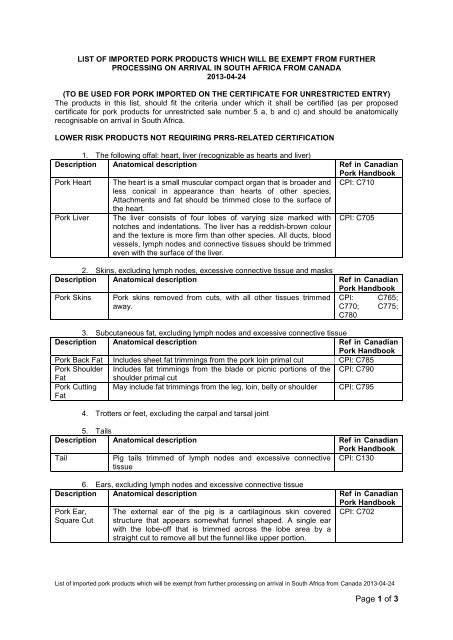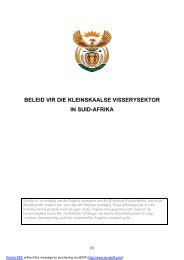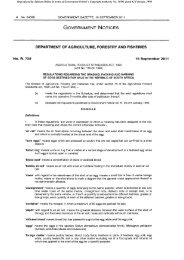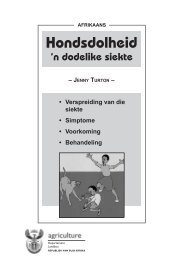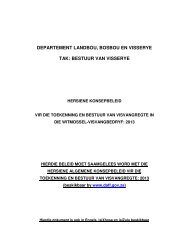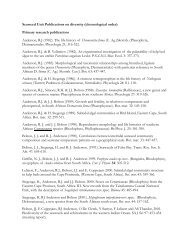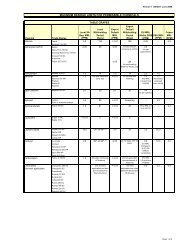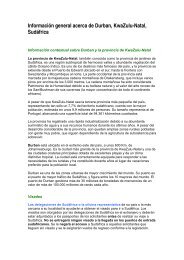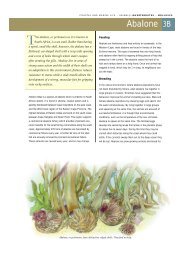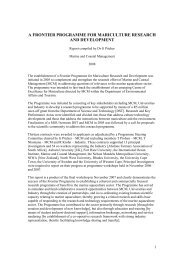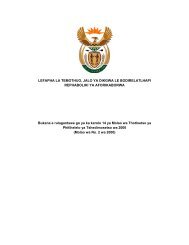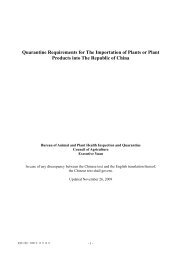Canada list of pork exempt pork cuts
Canada list of pork exempt pork cuts
Canada list of pork exempt pork cuts
Create successful ePaper yourself
Turn your PDF publications into a flip-book with our unique Google optimized e-Paper software.
LIST OF IMPORTED PORK PRODUCTS WHICH WILL BE EXEMPT FROM FURTHER<br />
PROCESSING ON ARRIVAL IN SOUTH AFRICA FROM CANADA<br />
2013-04-24<br />
(TO BE USED FOR PORK IMPORTED ON THE CERTIFICATE FOR UNRESTRICTED ENTRY)<br />
The products in this <strong>list</strong>, should fit the criteria under which it shall be certified (as per proposed<br />
certificate for <strong>pork</strong> products for unrestricted sale number 5 a, b and c) and should be anatomically<br />
recognisable on arrival in South Africa.<br />
LOWER RISK PRODUCTS NOT REQUIRING PRRS-RELATED CERTIFICATION<br />
1. The following <strong>of</strong>fal: heart, liver (recognizable as hearts and liver)<br />
Description Anatomical description Ref in Canadian<br />
Pork Handbook<br />
Pork Heart The heart is a small muscular compact organ that is broader and CPI: C710<br />
less conical in appearance than hearts <strong>of</strong> other species.<br />
Attachments and fat should be trimmed close to the surface <strong>of</strong><br />
the heart.<br />
Pork Liver The liver consists <strong>of</strong> four lobes <strong>of</strong> varying size marked with<br />
notches and indentations. The liver has a reddish-brown colour<br />
and the texture is more firm than other species. All ducts, blood<br />
vessels, lymph nodes and connective tissues should be trimmed<br />
even with the surface <strong>of</strong> the liver.<br />
CPI: C705<br />
2. Skins, excluding lymph nodes, excessive connective tissue and masks<br />
Description Anatomical description Ref in Canadian<br />
Pork Handbook<br />
Pork Skins<br />
Pork skins removed from <strong>cuts</strong>, with all other tissues trimmed<br />
away.<br />
CPI: C765;<br />
C770; C775;<br />
C780<br />
3. Subcutaneous fat, excluding lymph nodes and excessive connective tissue<br />
Description Anatomical description Ref in Canadian<br />
Pork Handbook<br />
Pork Back Fat Includes sheet fat trimmings from the <strong>pork</strong> loin primal cut CPI: C785<br />
Pork Shoulder Includes fat trimmings from the blade or picnic portions <strong>of</strong> the CPI: C790<br />
Fat<br />
Pork Cutting<br />
Fat<br />
shoulder primal cut<br />
May include fat trimmings from the leg, loin, belly or shoulder<br />
4. Trotters or feet, excluding the carpal and tarsal joint<br />
CPI: C795<br />
5. Tails<br />
Description Anatomical description Ref in Canadian<br />
Pork Handbook<br />
Tail<br />
Pig tails trimmed <strong>of</strong> lymph nodes and excessive connective<br />
tissue<br />
CPI: C130<br />
6. Ears, excluding lymph nodes and excessive connective tissue<br />
Description Anatomical description Ref in Canadian<br />
Pork Handbook<br />
Pork Ear,<br />
Square Cut<br />
The external ear <strong>of</strong> the pig is a cartilaginous skin covered<br />
structure that appears somewhat funnel shaped. A single ear<br />
with the lobe-<strong>of</strong>f that is trimmed across the lobe area by a<br />
straight cut to remove all but the funnel like upper portion.<br />
CPI: C702<br />
List <strong>of</strong> imported <strong>pork</strong> products which will be <strong>exempt</strong> from further processing on arrival in South Africa from <strong>Canada</strong> 2013-04-24<br />
Page 1 <strong>of</strong> 3
PRODUCTS INDIVIDUALLY AGREED UPON<br />
1. Bone-in or deboned meat free <strong>of</strong> lymph nodes and excessive connective tissue (must be<br />
certifiable and recognizable as such). The individual <strong>cuts</strong> and packaging will be specified<br />
on the import permit and health certificate.<br />
Bone-in or deboned meat free <strong>of</strong> lymph nodes and excessive connective tissue (must be<br />
certifiable and recognizable as such)<br />
Description Anatomical description Ref in Canadian<br />
Pork Handbook<br />
Pork Leg<br />
(Fresh Ham),<br />
Skinless,<br />
Boneless<br />
Pork Leg<br />
(Fresh Ham),<br />
Outside<br />
Muscle<br />
Pork Leg<br />
(Fresh Ham),<br />
Inside Muscle<br />
Pork Leg<br />
(Fresh Ham),<br />
Knuckle<br />
Pork Loin,<br />
Boneless<br />
Pork Loin,<br />
Short-Cut<br />
Back,<br />
Boneless<br />
Pork Loin,<br />
Short-Cut<br />
Back,<br />
Boneless<br />
All bones, cartilage, skin, rectus abdominis, cutaneous trunci, fat<br />
and lean above the aitch bone, plus lymph nodes shall be<br />
removed. The tendinous ends <strong>of</strong> shanks shall be removed so<br />
that the cross-sectional cut exposes not less than 75% lean. The<br />
loin end shall be exposed by a straight cut anterior to the<br />
quadriceps femoris. The cut shall not be less than 25mm and not<br />
more than 7.5cm from the anterior end <strong>of</strong> the femur pocket.<br />
The outside muscle complex consists <strong>of</strong> the outside leg muscles<br />
(biceps femoris, gluteus superficialis and semitendinosus) from<br />
the leg. The gastrocnemius may remain; however the flexor<br />
digitorum superficialis shall be removed. The popliteal lymph<br />
gland and surrounding fat in excess <strong>of</strong> 6mm in-depth shall be<br />
removed.<br />
The inside leg muscle consists <strong>of</strong> the semimembranosus and<br />
related muscles <strong>of</strong> the inside portion <strong>of</strong> the leg, which are<br />
removed from the outside and knuckle portions <strong>of</strong> the leg along<br />
the natural seam. All bones, cartilage, exposed heavy<br />
connective tissue, lean and fat overlying the aitch bone, and the<br />
gracilis membrane, shall be removed.<br />
The leg knuckle or sirloin tip consists <strong>of</strong> the knuckle portion <strong>of</strong><br />
the leg (the tensor fasciae latae and quadriceps group).<br />
All skin, bones, cartilage, the tenderloin, and lean and fat<br />
overlying the blade bone shall be removed. The leg-end <strong>of</strong> the<br />
loin shall be exposed by a straight cut which shows no evidence<br />
<strong>of</strong> the quadriceps femoris nor the longissimus. The sirloin may<br />
be removed immediately anterior to the hip bone pocket. In such<br />
casis, both the longissimus and gluteus medius shall be exposed<br />
on the “leg” end. On the shoulder-end, the longissimus shall be<br />
equal to , or larger than the combined areas <strong>of</strong> the splenius and<br />
semispinalis capitis. The belly shall be removed by a cut from a<br />
point ventral to, but not more than 5cm from the longissimus at<br />
the shoulder-end to a point on the leg-end, no more than 25mm<br />
ventral to the longissimus and/or gluteus medius.<br />
The tenderloin, all bones and cartilage shall be removed. On the<br />
blade end, the longissimus shall be approximately equal to, or<br />
larger than, the spinalis dorsi; the rhomboideus shall not be<br />
present. The sirloin is rmoved anterior to the hip bone cartilage,<br />
exposing the gluteus medius. The belly shall be removed by a<br />
cut from a point ventral to, but not more than 25mm from the<br />
longissimus at the blade end, to a point on the sirloin end ventral<br />
to, but not more than 25mm from the longissimus.<br />
All bones, cartilage, tenderloin, plus lean and fat overlying the<br />
blade bone shall be removed. The shoulder and sirloin ends<br />
shall be removed by straight <strong>cuts</strong> approximately parallel to each<br />
other. On the shoulder end, the longissimus shall be equal to, or<br />
larger than, the combined areas <strong>of</strong> the splenius and semispinalis<br />
capitis, and the sirloin shall be removed immediately anterior to<br />
the hip cartilage. The belly side shall be removed immediately<br />
ventral to the longissimus.<br />
CPI: C105<br />
CPI: C106<br />
CPI: C107<br />
CPI: C108<br />
CPI: C201<br />
CPI: C205<br />
CPI: C209<br />
List <strong>of</strong> imported <strong>pork</strong> products which will be <strong>exempt</strong> from further processing on arrival in South Africa from <strong>Canada</strong> 2013-04-24<br />
Page 2 <strong>of</strong> 3
Bone-in or deboned meat free <strong>of</strong> lymph nodes and excessive connective tissue (must be<br />
certifiable and recognizable as such)<br />
Description Anatomical description Ref in Canadian<br />
Pork Handbook<br />
Pork Loin,<br />
Short-Cut<br />
Back, Main<br />
Muscle,<br />
Boneless<br />
Pork<br />
Tenderloin<br />
Pork Sirloin,<br />
boneless<br />
Pork Belly,<br />
Skinless<br />
Commercial<br />
Trim;<br />
Pork Belly,<br />
Skinless,<br />
Square Cut;<br />
Pork Side<br />
Ribs, Breast<br />
Bone<br />
Removed<br />
(Excl rib 1 and<br />
rib 2)<br />
Pork Side<br />
Ribs, Centre<br />
Cut (Excl rib 1<br />
and rib 2)<br />
Pork Loin,<br />
Back Ribs<br />
(Excl rib 1 and<br />
rib 2)<br />
All bones, cartilage, tenderloin, plus lean and fat overlying the<br />
blade bone shall be removed. The shoulder and sirloin ends<br />
shall be removed by straight <strong>cuts</strong> approximately parallel to each<br />
other. On the shoulder end, the longissimus shall be equal to, or<br />
larger than, the combined areas <strong>of</strong> the splenius and semispinalis<br />
capitis, and the sirloin shall be removed immediately anterior to<br />
the hip cartilage. The belly side shall be removed immediately<br />
ventral to the longissimus.<br />
The tenderloin is removed intact and consists <strong>of</strong> the psoas<br />
major, psoas minor and iliacus only. The side strip muscle<br />
(psoas minor) shall be removed. The anterior portion (tail end)<br />
shall be trimmed so that the tail is not split more than 25mm. The<br />
tenderloin should be practically free <strong>of</strong> fat. All glandular and<br />
blood tissue should also be removed.<br />
The sirloin is the portion <strong>of</strong> the full loin that remains after the<br />
center-cut loin is removed by a straight cut anterior to the hip<br />
bone and related cartilage. When a long-cut leg is produced, the<br />
sirloin piece remains intact on the leg with the light butt portion.<br />
The belly is prepared from the side after removal <strong>of</strong> the leg,<br />
shoulder, loin, fat back and spareribs. All bones and cartilage<br />
shall be removed. Practically all leaf fat shall be removed. The<br />
fat back shall be removed by a straight cut not more than 3.8cm<br />
from the outermost dorsal curvature <strong>of</strong> scribe line. The anterior<br />
(shoulder) and posterior (leg) ends <strong>of</strong> the belly shall be<br />
reasonably straight and parallel. No side <strong>of</strong> the belly shall be<br />
more than 5cm longer than its opposing side. The width <strong>of</strong> the<br />
rectus abdominis shall be at least 25% <strong>of</strong> the width <strong>of</strong> the belly<br />
on the leg end. The fat on the ventral side <strong>of</strong> the belly, and<br />
adjacent to the flank, shall be trimmed to within 19mm from the<br />
lean. The area ventral to the scribe line shall be free <strong>of</strong> scores<br />
and “snowballs” (exposed areas <strong>of</strong> fat), which measure 19.4<br />
square cm or more. The belly shall be free <strong>of</strong> enlarged, s<strong>of</strong>t,<br />
porous, dark or seedy mammary tissue. The scribe line shall be<br />
not more than 6mm in depth at any point.<br />
Side ribs should contain at least 11 ribs and associated costal<br />
cartilages. The membranous portion <strong>of</strong> the diaphragm must be<br />
removed close to the lean. Any portion <strong>of</strong> the diaphragm not<br />
firmly attached should be removed close to the inside surface <strong>of</strong><br />
the ribs. The lean shall not extend more than 5cm past the<br />
curvature <strong>of</strong> the last rib and costal cartilage. Heart fat on the<br />
inside surface <strong>of</strong> the ribs shall not exceed 6mm average depth.<br />
Leaf fat over the diaphragm and transverse abdominis shall be<br />
trimmed practically free.<br />
As for C501 except the sternum and the ventral portion <strong>of</strong> the<br />
costal cartilage shall be removed along with the flank portion.<br />
The breast shall be removed at a point that is dorsal to the<br />
curvature <strong>of</strong> the costal cartilage.<br />
The back ribs should consist <strong>of</strong> at least 8 ribs and related<br />
intercostals meat from the loin. The back rib sections shall be<br />
intact, and the bodies <strong>of</strong> the thoracic vertebrae shall be removed.<br />
CPI: C211<br />
CPI: C227; C228<br />
CPI: C235<br />
CPI: C400;<br />
C401;<br />
CPI: C501<br />
CPI: C502<br />
CPI: C505<br />
2. Consumer ready <strong>cuts</strong> (as agreed upon). The individual <strong>cuts</strong> and packaging will be<br />
specified on the import permit and health certificate<br />
List <strong>of</strong> imported <strong>pork</strong> products which will be <strong>exempt</strong> from further processing on arrival in South Africa from <strong>Canada</strong> 2013-04-24<br />
Page 3 <strong>of</strong> 3


